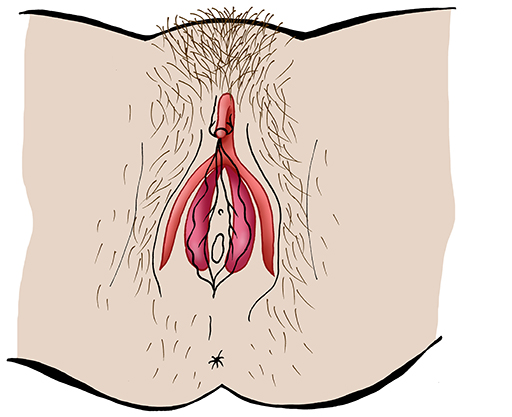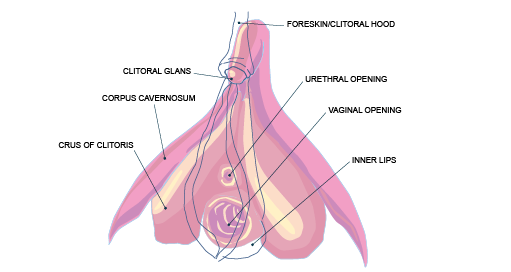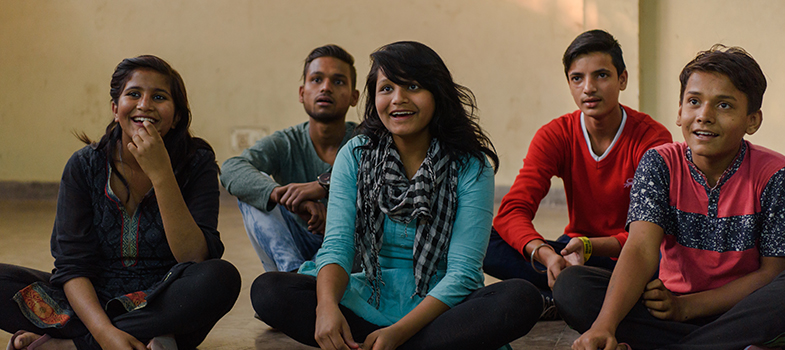4.4 Arousal and orgasms
The next activity develops knowledge about sexual pleasure by focusing on arousal and on the clitoris.
Watch the following film yourself first to make a decision about whether it is appropriate for you to use in your CSE classes. If you do decide to show it, perhaps to an older group, Activity 4.6 offers some suggestions on how to develop a discussion around it.
Activity 4.6 Lust and pleasure
Show the film Lust and pleasure:
Transcript
Information from RFSU about lust and pleasure.
Everyone is unique and this is
why you have to find your own way to
enjoy your body.
Some people think the most pleasurable thing is to be stroked
all over, while others enjoy putting something in the vagina.
Your body has many pleasurable places to discover.
Trying out new places can feel exciting.
Many people discover what gives them
pleasure and they often do the same
things each time they have sex.
Even though people can find pleasure all over
the body, some parts are particularly
sensitive to touch. The clitoris is the
part that is the most sensitive to
sexual touch. Stroking the clitoris is
also the way most women have an orgasm.
Parts of the clitoris are outside the
body. The head and the foreskin. If you've
been circumcised the outer parts may
have been removed but most of the
clitoris is inside the body. When you
become aroused the vagina opens and
becomes deeper, your sexual organs swell
and become extra sensitive to touch. The
erectile tissue of the clitoris is
filled with blood and you have an
erection. The same thing happens to the
penis, it swells and also becomes extra
sensitive to touch. This is particularly
true for the head of the penis.
When you become aroused slippery
moisture is created by the walls of your
vagina. This moisture is called
lubrication. If you don't have
lubrication it can be unpleasant or even
painful to have sex. The same is true for
putting something in the vagina. If you
don't have a lot of lubrication you can
use a lubricant but a lubricant won't
make sex pleasurable if you aren't
aroused at the same time. If you use a
lubricant together with a condom, only
use water or silicone-based lubricants
because using oil can make the condom
break. The most important pleasure centre
in your body is your brain, what you
think about and feel before sex about
your body and about your partner all
these have an effect on your ability to
enjoy sex. You have to want to have sex
in order to enjoy it.
You can have sex with others or by
yourself. Having sex with yourself is
called masturbation and it's something
most people do no matter what their
gender. Many also masturbate even if
they have a partner, sometimes together,
sometimes alone. Different things can be
pleasurable at different times, that's
why it's important to be open and
curious about the other person's wishes
and boundaries. Finding a way to show and
tell your partner what you like often
makes sex better and more pleasurable.
Now ask participants:
Was there anything in the film that was new to you or surprised you?
In your discussion, you may wish to bring out some of the following points.
Note:
You could also show the class the diagrams below, which are also in the image bank [Tip: hold Ctrl and click a link to open it in a new tab. (Hide tip)] .
You can also order a model life-size clitoris from RFSU (the Swedish Association for Sexuality Education) or other internet resources.


The clitoris
- The clitoris is much larger than people often assume and has internal and external parts.
- Stimulation of the clitoris is the most common way for women to have an orgasm.
Arousal
- The film focuses on arousal in the female body – people often focus more on arousal in the male body, but both are equally important to understand.
- You might want to include information about male arousal in the discussion, or at least be prepared for questions about it.
First-time sex
- There is a common myth that it will – or should – hurt for a woman or girl when she has vaginal intercourse for the first time.
- It’s connected to the myth about the hymen and that it is something that breaks the first time it’s penetrated, and that it can break from riding a horse or doing physical activities.
- It is also not true that all vaginal coronas tear and bleed the first time they are penetrated – in fact it is more common for them not to bleed.
Orgasm
- A simple way to explain an orgasm is to say that it is “the peak of sexual feeling”.
- An orgasm doesn’t feel the same every time; sometimes it is weaker, sometimes stronger.
- Very young children who have not reached puberty can also experience orgasms.
The ‘orgasm gap’
- Men have orgasms more often than women when they have sex with a partner.
- Women have more orgasms when they have sex with another woman, but significantly fewer when they have sex with a man.
- Men have the same number of orgasms whether their partner is a man or a woman.
- Here you could ask the group why they think men have more orgasms than women.
4.3 The sexual organs
